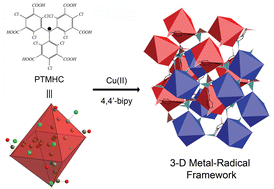An octahedral hexacarboxylic polychlorotriphenylmethyl radical (PTMHC) and its hydrogenated precursor (αH-PTMHC) have been reacted with Cu(II) and 4,4′-bipyridine to prepare two isomorphic three-dimensional (3-D) coordination polymers of formula [Cu6(PTMHC)2(4,4′-bipy)3(H2O)12]n (1) and [Cu6(αH-PTMHC)2(4,4′-bipy)3(EtOH)6(H2O)6]n (2). Both 3-D structures can be described as two interpenetrating primitive cubic nets connected through bipyridine linkers, which defines an unusual topology with Schläfi symbol of (62·81)·(66·89). Magnetic properties of both metal–organic frameworks have been studied in detail. 2 shows weak antiferromagnetic interactions between Cu(II) ions at low temperature. In contrast, 1 reveals unexpected metal–radical ferromagnetic interactions (θ = 2.1 (2) K). Information on the existence of magnetic ordering and the nature of the ordered phase for 1 has been investigated via very low temperature magnetic susceptibility measurements. Surprisingly, the experimental data indicate the occurrence of 3-D antiferromagnetic ordering below 0.5 K. This latter phenomenon has been explained with specific heat measurements. Experimental results reveal the coexistence of relatively strong ferromagnetic interactions with weaker antiferromagnetic ones, mediated through the bipyridine linkers, which finally determine the low temperature magnetic structure. A deeper study of the data allows the analysis of the magnetic behavior of 1 as a 3-D antiferromagnet, with TC = 0.39 K, with ferromagnetic exchange interactions that do not propagate with equal strength along the three crystallographic directions above this temperature.

You have access to this article
 Please wait while we load your content...
Something went wrong. Try again?
Please wait while we load your content...
Something went wrong. Try again?


 Please wait while we load your content...
Please wait while we load your content...